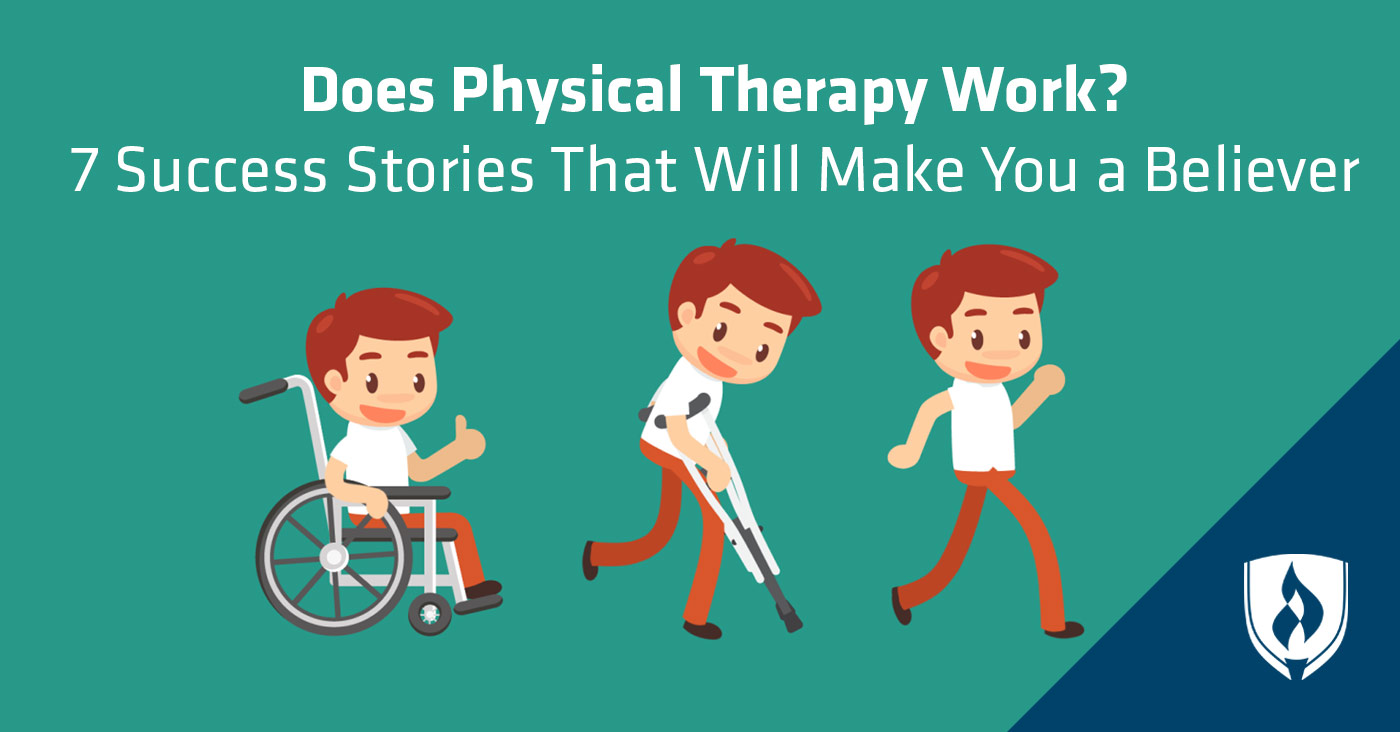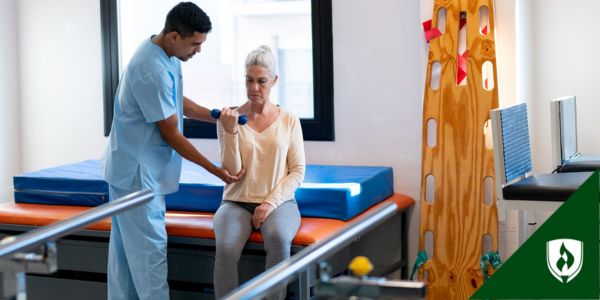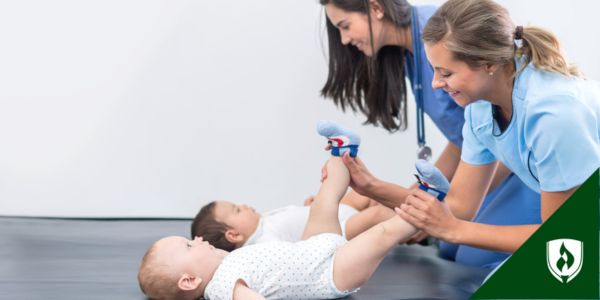Does Physical Therapy Work? 7 Success Stories That Will Make You a Believer
By Jess Scherman on 10/10/2017
If you or a loved one has experienced ongoing pain from a recurring or one-time injury, the idea of participating in physical therapy has likely been a topic of conversation. There are many reasons a patient might initially feel that physical therapy isn’t right for them—maybe they’re eager for instant relief, maybe the amount of work that goes into a physical therapy regimen seems unappealing, maybe they’re worried about dealing with insurance coverage or it’s possible they simply don’t understand the science behind the field and they’re not convinced it will work.

No matter the reason behind the skepticism, it’s important to know that physical therapy professionals dedicate their working lives to helping patients reduce pain and improve or restore mobility. In many cases, physical therapy aides in the avoidance of expensive surgeries and the prolonged use of prescription medications, according to the American Physical Therapy Association (APTA). Physical therapists teach patients how to prevent or manage their conditions to achieve long-term benefits.
But physical therapy is more than just a powerful solution to pain management—it can actually be incredibly cost-effective. In fact, according to a recent study, the initial treatment costs for patients who experienced lower back pain were 50 percent lower when the primary care visit was followed by a referral to visit a physical therapist. What’s more? Patients who opted to use physical therapy as an initial course of treatment saw 72 percent fewer costs within the first year.
While the statistics are compelling on their own, you don’t have to rely on numbers alone to convince you of the true benefits of physical therapy. Take a look at these seven amazing physical therapy success stories from patients and providers alike. Moreover, delve into our article on "Physical Therapy Benefits" to explore the comprehensive advantages of physical therapy in enhancing health and well-being.
7 Life-changing physical therapy success stories
1. A multiple sclerosis patient’s journey toward lifesaving treatment
Dave Bexfield was diagnosed with multiple sclerosis (MS) in 2006. Refusing to let the disease disable his sense of adventure, he spent the next three years actively hiking, biking and snowboarding worldwide. In the fall of 2009, he came across an opportunity to apply for a risky but potentially groundbreaking NIH-sponsored clinical trial in which he’d receive a stem-cell transplant for his increasingly aggressive case of MS.
To qualify for the trial, candidates were required to be able to walk 100 meters unaided. “No problem,” Bexfield thought, explaining that he could go nearly ten times that far. The next step of the process was awaiting insurance approval, and as he did, his legs continued to fail more and more rapidly.
“By the New Year, I couldn’t cross my living room floor without a walker. The progression was blinding and scary,” he recalls. It was at this time when the researchers informed Bexfield that the trial would be permanently closing to new patients in one month’s time. “I had a month to relearn how to walk with no canes, crutches or walkers.”
Aware of the urgency of his situation, Bexfield’s sister—a practicing physical therapist—sprang into action.
“She came to my house virtually every day that January, working with me on the walker, then forearm crutches, then a single cane and then nothing at all,” he says, adding that she used every trick in her physical therapy book and then some. Every day he inched closer to his goal, he also got closer to the clinical trial deadline.
With just days to spare, he walked the required 100 meters, qualifying for the trial, which Bexfield says saved his life. He now runs ActiveMSers.org to motivate others with MS to stay as active as possible.
2. A remarkable double-knee replacement recovery
Dr. Jenny Steffen PT, DPT, CSCS, works as a traveling physical therapist, contracting with organizations across the United States. In doing so, she’s worked in a number of different settings typical to the physical therapy field, including clinics, hospitals and nursing homes. In her wealth of experience, one particular patient’s story stands out.
“The patient had a double knee replacement, which can be a physical therapist’s nightmare,” Steffen explains. Although this procedure is more typical for an older patient base, this patient was a very young kindergarten teacher who was extremely active but had developed bilateral knee pain. Because the surgery and recovery process can be very difficult, the young woman endured a short stay in a nursing home, where Steffen met her for therapy sessions.
After a two-week stay, the patient was cleared to go home, continuing intermittent therapy sessions to ensure an effective recovery. Just as she was ending her therapy, Steffen took a new job across the country. But shortly after her departure, she received an email from the patient informing her that she had not only been able to return to work, but she was also able to start golfing again and even participated in a 5k race!
“Her progress was incredible,” Steffen says, explaining that the patient was committed to her recovery and very compliant during the process, which made her job very easy. “She surprised me, as well as herself, in how well she tolerated a very intense surgery and how she was able to bounce back so quickly.”
3. A runner who regained his stride
In the summer of 2016, Jerry Snider ruptured his PCL (posterior cruciate ligament), tore his MCL (medial collateral ligament) at a grade three level and endured some additional damage to his left knee while attempting a complicated trick on water skis. “I’ve water-skied all my life and, at age 42, decided I could attempt this trick I had never done,” he reminisces.
Snider—exercise physiologist and owner of All in Health and Wellness—had been a lifelong runner, having competed at Texas A&M in both cross country and track. In fact, he was in the midst of training for a half-marathon at the time the injury occurred. While his orthopedic surgeon assured Snider that his injuries wouldn’t require surgery, he broke the news that even with months of therapy, he was not confident he’d be able to run his December race.
“I began physical therapy with a brace on my knee about eight weeks after the injury occurred,” Snider says. He paired up with a physical therapist who was also a former competitive runner, hoping she’d understand his drive to streamline his recovery. She didn’t know if his half-marathon was possible, but she was willing to do her part to try to get him race-ready.
Snider went to hour-long therapy sessions three days a week, while also completing at least one hour of at-home therapy each day. When he visited his orthopedic surgeon once more in the fall, he was still advised against competing in December. Refusing to give up hope, Snider eventually connected with his former team doctor from Texas A&M and soon found himself running for three-minute increments on the treadmill.
Prescribed to continue routine physical therapy exercises, to always wear a knee brace when active and to not ignore any pain he may experience when running, Snider got the go-ahead from his former team doctor and his physical therapist to participate in the big race. When December rolled around, he finished the half-marathon third in his age group and placed 60th out of more than 1,800 total participants!
4. A patient re-learning how to walk
Amy Garrigues, PT, DPT and executive director of the School of Health Sciences at Rasmussen College, first met her patient, Mark, after he had been hit by a bus. The accident resulted in fractures to his lower back, pelvis, left femur and the lower halves of both his left and right legs.
Garrigues recalls that when she first met Mark, he was wheelchair-bound with both legs in casts and living on a hospital bed in his mother’s living room. Unable to bear any weight on his legs, it was extremely difficult for him to travel back and forth to therapy, as he was entirely reliant on the assistance of a second party. “The trip was exhausting,” she recalls. “I worked with Mark on his first visit so that he could perform exercises at home until the physician allowed him to bear weight through his legs.”
Two months later, the patient was able to return to the physical therapy clinic. At this point, his feet had not touched the ground in three months. “It took another month before Mark was able to stand for 30 seconds with a walker,” Garrigues explains. “From there, the milestones came fast. He was able to transfer himself in and out of his wheelchair, and on and off the toilet. He was able to get in and out of his mother’s car. He took a few steps.”
Remarkably, after vigilant physical therapy with Garrigues, Mark was able to begin walking consistently with his walker within a few more months. He then progressed to walking with crutches, and then with only a cane. “These were all great accomplishments,” Garrigues expresses, “but prior to his injury, Mark ran, jumped, played basketball and worked 16 hours a day on his feet. He wasn’t sure he’d ever do any of those things again.” While he had made astounding progress, he was still only able to stand for about 10 minutes before needing to sit and regain his strength.
With the guidance and encouragement of Garrigues, Mark joined a gym, scheduling time every day to bike, walk on the treadmill and perform strength exercises. They worked consistently to solve any mobility problems that interrupted his daily life and adjust his therapy goals as needed. The hard work paid off. Fast forward two years, and Mark invited his physical therapist to attend his wedding.
“I was able to witness him walk up four stairs to the altar—one foot over the other, no railings—to join his bride,” Garrigues recalls.
“As I reflect on his case, he was successful because we were able to forge a partnership,” she says. “Mark had specific goals that we were able to break up into manageable pieces and create a strategy that fit within his lifestyle.”
While Mark continues to face some challenges, he’s been equipped to meet and overcome them primarily on his own, thanks to his years of diligent physical therapy.
5. An innovative approach to treating scoliosis
Rebecca Ruesch was diagnosed with scoliosis when she was about 11 years old. Soon after, she and her parents met with an orthopedic surgeon who told them that if the angles of the curves in her spine got worse, she would need to wear a back brace. Sure enough, it was determined a few months later that her curves had progressed significantly enough to require the brace.
She was fitted for a Boston (TLSO) brace just a few weeks later. “The first few weeks of wearing that brace was probably the hardest part of my entire treatment,” Ruesch recalls. “It’s new and painful and it feels like you’ll never be comfortable again.” Intent on avoiding surgery, however, she followed the guidelines religiously, wearing her brace for 23 hours every day. At the time, she was told physical therapy would not help her condition, and that she simply had to wear her brace and await the positive results they hoped for.
It was around this time that Ruesch’s parents met physical therapist Cindy Marti at a neighborhood Christmas party. In discussing their daughter’s diagnosis and treatment plan, Marti informed them about the Schroth method of physical therapy and its alternative treatment plan.
“As luck would have it, she needed a ‘guinea pig’ patient to complete her certification,” Ruesch recounts. “After two weeks of an intense physical therapy boot camp, she was certified and I was trained in Schroth.” Her new team of providers suggested she transition to the Cheneau brace to better complement her new physical therapy regimen. Sure enough, with the combination of her new brace and her Schroth therapy routine, the curves in Ruesch’s spine began to stabilize.
After more than five years of bracing total—one year in a Boston brace and over four years in the Cheneau brace while participating in physical therapy—she was finally able to quit her brace and avoid undergoing spinal fusion surgery.
6. A solution that finally worked
Consulting with patients who have unsuccessfully tried a number of different methods for pain relief is a common experience for physical therapists. So it was when Dr. Todd Sayer PT, MBA—physical therapist and regional director for ATI Physical Therapy—met a patient who suffered from chronic lower-back pain and had tried everything from chiropractic care, massage therapy and anti-inflammatories to seek respite from the affliction.
After an initial consultation, Sayer diagnosed the patient’s pain as primarily sacroiliac dysfunction. The sacroiliac joint plays an important role in connecting our spines to our pelvises, acting as a shock-absorbing structure. Pain in this area is most commonly attributed to either hypermobility (too much movement) or hypomobility (too little movement). Sayer designed a recovery regimen for the patient that included manual therapy techniques such as joint mobilization and myofascial release, along with a home exercise program that empowered the patient to self-manage the symptoms.
Over time, proper strength training could be incorporated, as well as behavioral modification—something many may overlook when seeking relief from daily pain. This modification included training the patient for proper sitting when seated at a desk or computer work station to improve overall ergonomics. This also included training regarding sleep positions that can greatly impact the spine.
“Educating the patient was a key factor throughout,” Sayer explains, “Making them aware of the nature of the pain cycle, the mechanical nature of their dysfunction and how the exercises and behavioral modification applied to that.”
7. A sought-after solace from chronic pain
For many years, Angel Barrino—publisher, author, inspirational speaker and life coach with Angel B. Inspired Inc.—lived with chronic and intermittent pain throughout her entire body, spurred on from a fall in the shower, among other things. Most recently, the pain centralized in her lower back, legs and right hip. It progressed so severely that she began walking with a limp without even noticing it. “Pain pills had become one of my best friends because it was the only way I could get any relief,” she recounts.
That is when Barrino knew she needed to seek some help. After an initial consultation, her medical provider quickly referred her to a physical therapist. “When I first started, I could barely move, and the pain was so excruciating I would cry myself to sleep at night,” she says. But, desperate for her physical therapy regimen to provide the relief she’d been seeking, Barrino persisted.
With the combination of customized exercise routines, therapeutic massage, personalized stretches and electric stimulation therapy, her persistent pain finally became manageable in about two months’ time. Barrino went from her chronic pain ranking at a 10—the highest level of the medical pain scale—all the way down to a range from one to three. Her limp has all but disappeared as well.
Could you play a part in the life-changing practice of physical therapy?
As you can see by the incredible testimonies of these brave patients and dedicated providers, physical therapy can work wonders, changing—and even saving—lives in the process. When physical recovery and a respite from pain are achieved, physical therapy patients can go on to accomplish incredible things in their lives.
If you’re eager to help people, and you’re drawn to the field of physical therapy, but you’re wary about the time and rigorous work it takes to obtain the required doctoral degree, you might consider pursuing a career as a physical therapist assistant. To learn more about whether this might be a good option for you, check out our article, “7 Signs You Should Consider Becoming a Physical Therapist Assistant.”
RELATED ARTICLES:




